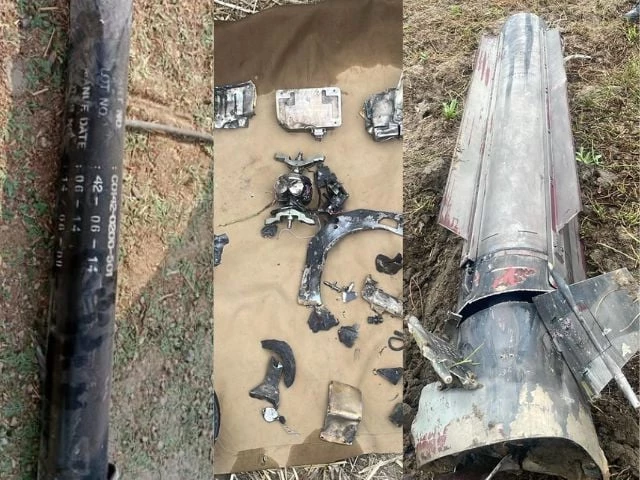Number of Indian drones downed by Pakistan reaches 77
Five civilians martyred in Indian shelling on civilian population along LoC, security sources.

The Pakistan army intercepted and destroyed 77 Israeli-made Harop drones, sent by India to target civilian and military installations, Federal Minister for Information Atta Tarar confirmed on Friday.
At least 29 drones were intercepted since Wednesday until Thursday evening, with an additional 48 shot down overnight and into Friday.
On the Line of Control (LoC), security sources said, five civilians were martyred and seven others injured in unprovoked Indian shelling on residential areas.
The shelling targeted Hajeera, Forward Kahuta, and Khuiratta areas using heavy artillery, causing civilian casualties and structural damage, they say.
Indian forces are using heavy artillery to target civilian populations along the LoC, according to security sources. The shelling has prompted a strong and immediate response from the Pakistan Army, they added.
According to security sources, Indian troops also raised a white flag near Dharamsal 2 post opposite Battal sector after sustained retaliation by the Pakistan Army.
Pakistan Army officials emphasised that any aggression along the LoC will be met with a swift and effective response.
Tensions between Pakistan and India have sharply escalated following a series of events that began with a deadly attack in Pahalgam, located in Indian Illegally Occupied Jammu and Kashmir (IIOJK), on April 22.
The attack claimed 26 lives, primarily tourists. India blamed the incident on elements based in Pakistan, though no supporting evidence was publicly released. Pakistan has strongly denied the allegations.
In response to the Pahalgam attack, India took a series of diplomatic and administrative actions, including closing the Wagah-Attari land crossing, suspending the Indus Waters Treaty, and revoking Pakistani visas on April 23. Pakistan responded by sealing its side of the Wagah border and warned that any obstruction of water flow would be considered an act of war.
Hostilities intensified on the night of May 6–7, when Indian armed forces reportedly conducted coordinated missile, air, and drone strikes on several locations within Pakistani territory. Areas targeted included Sialkot, Shakargarh, Muridke, and Bahawalpur in Punjab, as well as Kotli and Muzaffarabad in Azad Jammu and Kashmir (AJK).
According to the Inter-Services Public Relations (ISPR), the attacks led to the deaths of at least 31 civilians, including women and children, and left 71 others injured. Civilian infrastructure, such as mosques and the Neelum–Jhelum Hydropower Project, also sustained damage.
In a retaliatory operation, Pakistan’s military reported the downing of five Indian Air Force jets and one combat drone. The aircraft were identified as three Rafale jets, one MiG-29, one SU-series jet, and an Israeli-made Heron drone, which were said to be shot down in areas including Bhatinda, Jammu, Akhnoor, Srinagar, and Avantipur.
Read more: 'Will avenge every drop of martyrs' blood,' PM warns India
What is Harop?
According to a Times of Israel report, the Harop, manufactured by Israel Aerospace Industries, is a loitering munition that can fly to targets and then attack by crashing into them on command from the operator, destroying itself in the process.
The Harop is equipped with electro-optical (EO), infrared (IR), and forward-looking infrared (FLIR) sensors, as well as a colour CCD camera and anti-radar homing capabilities, providing target detection and identification, says a Eurasian Times report.
It further states that Harop can seek targets in a designated area for nine hours, locate and identify them, plan an attack route, and then pursue the strike from any direction at shallow or steep dive angles. Due to its immunity to GNSS jamming, Harop overcomes communication challenges.
Launched from canisters mounted on trucks or naval vessels, Harop is easily deployed from diverse terrains and environments. The drone will return to the base if a target is not engaged. It has been designed to minimise its radar signature through stealth (low observability).
Why India used Harop?
According to Pakistani security sources, the Indian Air Force (IAF) might be hesitant to launch further manned air missions after losing five of its warplanes in the air combat with PAF on the night between May 6 and 7.
They further said that India was trying to divert attention from its military setbacks with such provocative actions to appease the domestic audience. The military said that it remained on high alert, responding to each act of aggression with a "firm and proportionate" approach.
It was a huge embarrassment for India when it launched a missile strike on Pakistan but lost five of its jets, including three modern Rafale aircraft, in air combat during the retaliation from the PAF. New Delhi hasn't officially confirmed the downing of Rafale jets.
However, a senior French intelligence official confirmed to CNN that one Rafale jet had indeed been shot down by Pakistan, marking the first time one of these advanced French aircraft had been lost in combat.
An American commentator on CNN remarked that the potential loss of Rafale jets would deal a significant blow to India's claim of air superiority, which it had built around the induction of these French-made warplanes.
Some experts suggested that the confrontation between the two countries served as a test of both Chinese and Western military technologies, particularly after Pakistan's acquisition of J-10C jets from China in response to India's Rafale fleet. Analysts have noted that China's J-10C jets are proving to be highly effective, potentially shifting the regional balance of power.





















COMMENTS (1)
Comments are moderated and generally will be posted if they are on-topic and not abusive.
For more information, please see our Comments FAQ